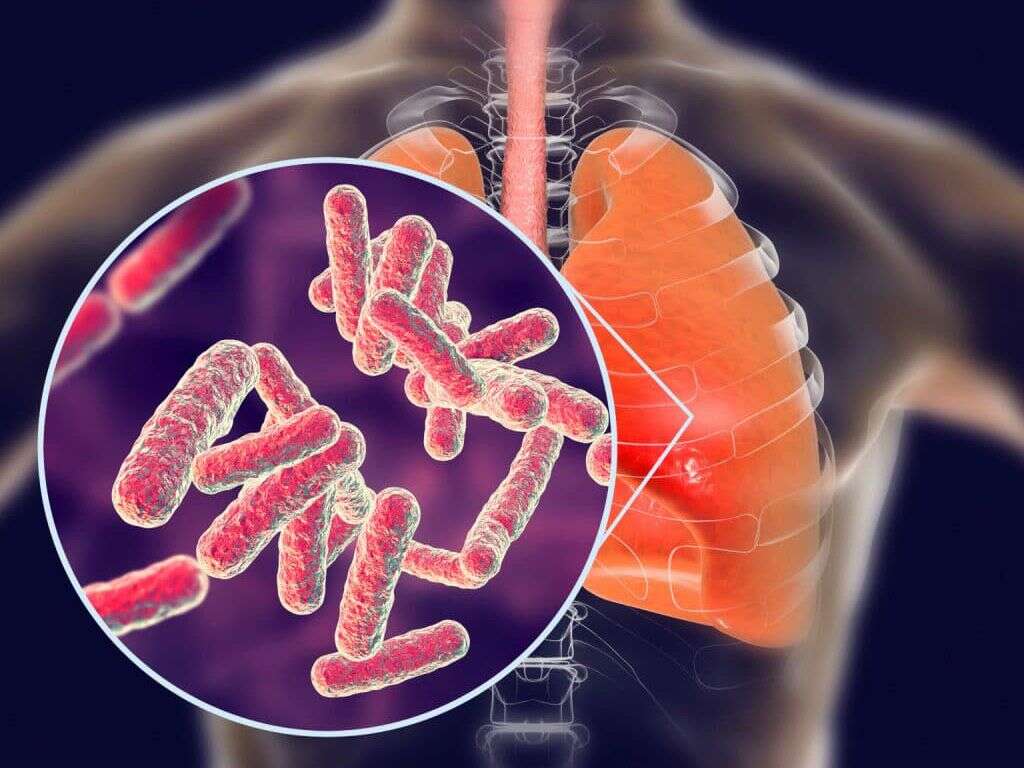10 Symptoms of TB
 Article Sources
Article Sources
- 1. World Health Organization. (2020). Tuberculosis (TB). Retrieved November 13, 2020, from https://www.who.int/news-room/fact-sheets/detail/tuberculosis
- 2. Rosha, D. (2002). Prolonged Fever During The Treatment Of Pulmonary Tuberculosis. Medical Journal Armed Forces India, 58(2), 127-129. doi:10.1016/s0377-1237(02)80045-4
- 3. Mahmoudi, A. (1993). Pitfalls in the Care of Patients With Tuberculosis. Jama, 270(1), 65. doi:10.1001/jama.1993.03510010071032
- 4. Hernández-Garduño, E., & Pérez-Guzmán, C. (2007). Appetite and tuberculosis: Is the lack of appetite an unidentified risk factor for tuberculosis? Medical Hypotheses, 69(4), 869-872. doi:10.1016/j.mehy.2007.02.006
- 5. Saloman, L. (2016). Examining Disease Characteristics and Patterns of Weight Gain in Tuberculosis Treatment. Retrieved November 13, 2020, from https://www.contagionlive.com/view/examining-disease-characteristics-and-patterns-of-weight-gain-in-tuberculosis-treatment
Tuberculosis results from an infection with the Mycobacterium tuberculosis bacterium. Once active, TB can affect virtually any part of the body. The most common area of infection, however, is the lungs. This is known as pulmonary tuberculosis. According to the World Health Organization, it was responsible for 1.4 million deaths in 2019.1World Health Organization. (2020). Tuberculosis (TB). Retrieved November 13, 2020, from https://www.who.int/news-room/fact-sheets/detail/tuberculosis
Most people who contract tuberculosis become latent carriers, meaning they never develop symptoms and cannot spread the illness to others. Those who go on to develop active infections can experience a host of symptoms. Keep reading to learn about the 10 most common symptoms of pulmonary tuberculosis.

1. Prolonged Cough
People who develop symptoms from a tuberculosis infection often experience a prolonged cough. It tends to last for three weeks or more and can become severe. Patients with a forceful TB-induced cough often cough up sputum — mucus from deep within the lungs.
A cough develops with TB because the bacteria have invaded the lungs. As that infection grows, damage can occur to lung tissue. Left untreated, this can prove to be permanent and, in severe cases, fatal. Taking a course of approved antibiotics can cure most cases of TB. However, the rate of drug-resistant strains is increasing.

2. Coughing Up Blood
Mucus is not the only thing that TB patients cough up. It is quite common for them also to bring up blood. This happens when infections cause damage to blood vessels inside the lungs. When left unchecked, damage results in a breakdown of blood vessels.
Those blood vessels can leak into the open lung cavities and manifest in the appearance of bright red blood coughed up along with other respiratory droplets. This blood may appear frothy or bubbly because it is mixed with air from inside of the lungs.

3. Fever
Many patients who are eventually diagnosed with TB experience a fever. Some will report an unusually high temperature, while others experience persistent low-grade fevers. Fever occurs in as many as 85% of patients who test positive for pulmonary tuberculosis.2Rosha, D. (2002). Prolonged Fever During The Treatment Of Pulmonary Tuberculosis. Medical Journal Armed Forces India, 58(2), 127-129. doi:10.1016/s0377-1237(02)80045-4 Fevers are a natural defense mechanism as the body attempts to kill pathogens with high temperatures.
Fevers generally resolve in the first two weeks of effective treatment with antibiotics. There are times when fevers do not fully resolve after treatment. This can be an indication of other problems, such as drug resistance or a secondary infection. Errors in treating the tuberculosis infection can compound these issues.3Mahmoudi, A. (1993). Pitfalls in the Care of Patients With Tuberculosis. Jama, 270(1), 65. doi:10.1001/jama.1993.03510010071032

4. Chills
Chills are most commonly reported alongside a fever or just before one develops in tuberculosis patients. They happen as a result of rapid contractions and relaxation of muscles that the body performs to raise the core body temperature to a high enough level to fight off infection.
In addition to the trembling caused by muscle contractions, most patients who develop chills also become pale and feel cold. Bundling up or adding extra layers can make chills worse by further elevating core temperatures.

5. Night Sweats
Night sweats result in a patient waking up in the middle of the night drenched. The sweating is profuse enough that bedclothes and bedding will often need to be changed. TB is one of the most widespread infectious causes of night sweats. That makes it a prime diagnostic symptom and one that should be shared with any medical providers.
Tuberculosis is not the only cause of night sweats. They can result due to several other infections, such as malaria. Hormonal changes associated with menopause are a common culprit of night sweats for many women. Sleep apnea, GERD, certain types of seizures and some medications may also induce excessive night sweating.

6. Loss of Appetite
Many patients who develop an active TB infection have decreased appetite, which can be compounded by nausea. Reduced appetite can lead to malnutrition and a suppressed immune response, so it is essential to maintain proper nutrition throughout treatment.
Researchers are working to understand the complicated relationship between appetite and TB. There is a correlation between malnutrition, a chronic loss of appetite and worse outcomes from tuberculosis. Active infection can cause a decrease in food cravings, but that is not always the case. A diminished appetite may be an underlying cause for latent infection to become active in many people.4Hernández-Garduño, E., & Pérez-Guzmán, C. (2007). Appetite and tuberculosis: Is the lack of appetite an unidentified risk factor for tuberculosis? Medical Hypotheses, 69(4), 869-872. doi:10.1016/j.mehy.2007.02.006

7. Unintended Weight Loss
TB patients often experience rapid and excessive weight loss, also called wasting. Since this excessing weight loss often appeared as if the body was consumed from the inside out, it may be responsible for the term consumption that was historically used to describe the illness. Wasting may be associated with a loss of appetite, but that is not always the primary cause. Nausea and vomiting can cause nutritional efficiencies that also lead to weight loss and can be aggravated by certain treatment regimens.
Weight loss compounds active TB infections by undermining the immune system. Patients who do not meet nutritional needs are less able to fight off infection and more likely to die from their TB infection.5Saloman, L. (2016). Examining Disease Characteristics and Patterns of Weight Gain in Tuberculosis Treatment. Retrieved November 13, 2020, from https://www.contagionlive.com/view/examining-disease-characteristics-and-patterns-of-weight-gain-in-tuberculosis-treatment Consequently, weight gain is a sign that treatment is working.

8. Weakness
Weakness is the loss of strength in one or more muscles. It is common with certain neuromuscular disorders and can also result from an electrolyte imbalance, cancer or several other conditions. One of those is tuberculosis. Sometimes weakness is confused with a general feeling of malaise that occurs without measurable loss of muscle strength.
The weakness associated with TB may be due to nutritional deficiencies. Extreme weakness can occur in TB cases where the patient cannot meet dietary needs and experiences muscle wasting. This involves a marked decrease in muscle mass and can continue to the point of limiting normal function and movement.

9. Fatigue
Tuberculosis patients often experience extreme tiredness and fatigue. This is not normal tiredness after a long day, but rather extreme exhaustion where patients cannot complete everyday tasks. In some cases, they may feel unable to perform basic actions like getting dressed.
Tuberculosis-associated fatigue may be the result of the body’s efforts to fight off infection. It is commonly found in infectious diseases, especially in prolonged cases. It is also closely associated with fever, which is a common symptom of TB infection.

10. Chest Pains
Chest pain is occasionally the presenting symptom in a TB diagnosis. It can be directly related to lung damage, but it is more commonly associated with muscular pain and discomfort. In some patients, it may be due to nerve damage in the area of infection.
Chest pain can range from mild discomfort to intense, sharp pains. The violent coughing associated with TB only exacerbates the discomfort. While it is not the primary cause, lung involvement in pulmonary tuberculosis can also lead to chest pains.



-06.jpg)




